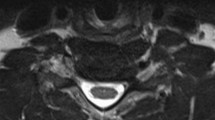Abstract
Objective.Clinical utility of high intensity repetitive transcranial electrical stimulation (rTES) to elicit a response in external anal and urethral sphincter muscles was investigated in 23 patients undergoing spine surgery. Methods.During surgery, motor evoked potentials (MEPs) were recorded from external anal sphincter (EAS), external urethral sphincter (EUS), and tibialis anterior (TA) muscles following high voltage rTES under total intravenous anesthesia. Results.No neurologic sequelae occurred during or after the rTES of the motor cortex. Onset latency for the EAS muscle was 20.2 ± 3.5 msec which was not significant compared to the EUS muscle latency at 19.9 ± 1.8 msec. The average electrical intensity to evoke EAS response was 789 ± 78 volts compared to the 831 ± 11 volts of the EUS muscle. Waveform latency for the TA muscle was robust in all cases while the latencies for EAS and EUS were not always clear. Conclusions.This preliminary study shows that intraoperative MEP monitoring of the external anal and urethral muscles is feasible method in particular in circumstances where bowel and bladder function are at risk of an inadvertent injury due to surgical manipulation.
Similar content being viewed by others
REFERENCES
Turnbull GK, Hamdy S, Aziz Q, et al. The cortical topography of human anorectal musculature. 1999; 117: 32-39
Penfield W, Rasmussen T. The cerebral cortex of man. NewYork: MacMillan, 1957: 209-212
Woolsey CN, Erickson TC, Gilson WE, et al. Localisation in somatic sensory and motor areas of human cerebral cortex as determined by direct recording of evoked potentials and electrical stimulation. J Neurosurg 1979; 51: 476-506
Pelosi L, Lamb J, Grevitt M, et al. Combined monitoring of motor and somatosensory evoked potentials in orthopaedic spinal surgery. Clin Neurophysiol 2002; 113: 1082-1091
Dong CC, Macdonald DB, Janusz MT. Intraoperative spinal cord monitoring during descending thoracic and thoracoabdominal aneurysm surgery. Ann Thorac Surg 2002; 74 (S1873-6)
Sala F, Krzan MJ, Deletis V. Intraoperative neurophysiological monitoring in pediatric neurosurgery:Why, when, how?Childs Nerv Syst 2002; 18: 264-287
Inoue S, Kawaguchi M, Takashi S, et al. Intraoperative monitoring of myogenic motor evoked potentials from the external anal sphincter muscle to transcranial electrical stimulation. Spine 2002; 27: E454-E459
Ertekin C, Hansen MV, Larsson LE, et al. Examination of the descending pathway to the external anal sphincter and pelvic floor muscles by transcranial cortical stimulation. Electroencephalogr Clin Neurophysiol 1990; 75: 500-510
Merton PA, Hill DK, Morton HB, et al. Scope of a technique for electrical stimulation of human brain, spinal cord, and muscle. Lancet 1982; 8298: 597-600
Herdmann J, Bielefeldt K, Enck P. Quantification of motor pathways to the pelvic floor in humans. Am J Physiol 1991; 260: G720-G723
Loening-Baucke V, Read NW, Yamada T, et al. Evaluation of the motor and sensory components of the pudendal nerve. Electroencephalogr Clin Neurophysiol 1994; 93: 35-41
Hostege G, Tan J. Supraspinal control of motoenurons innervating the striated muscles of the pelvic floor including urethral and anal sphincters in the cat. Brain 1987; 110: 1323-1344
Calancie B, Klose KJ, Bajer S, et al. Isoflorane-induced attenuation of motor evoked potentials caused by electrical motor cortex stimulation during surgery. J Neurosurgery 1991; 74: 897-904
Haghighi SS, Green D, Oro JJ, et al. Depressive effect of isoflourane anesthesia on motor evoked potentials. Neurosurgery 1990; 26: 993-997
Hicks R, Burke D, Stephen J, et al. Corticospinal volleys evoked by electrical stimulation of human motor cortex after withdrawal of volatile anaesthetics. J Physiol 1992; 456: 393-404
Author information
Authors and Affiliations
Rights and permissions
About this article
Cite this article
Haghighi, S.S., Zhang, R. Activation of the external anal and urethral sphincter muscles by repetitive transcranial cortical stimulation during spine surgery. J Clin Monit Comput 18, 1–5 (2004). https://doi.org/10.1023/B:JOCM.0000025283.58815.89
Issue Date:
DOI: https://doi.org/10.1023/B:JOCM.0000025283.58815.89




